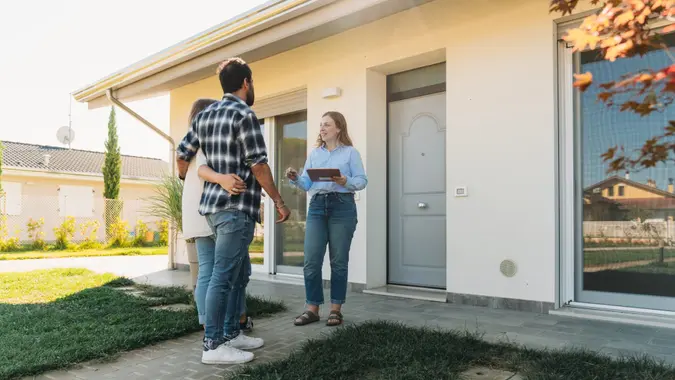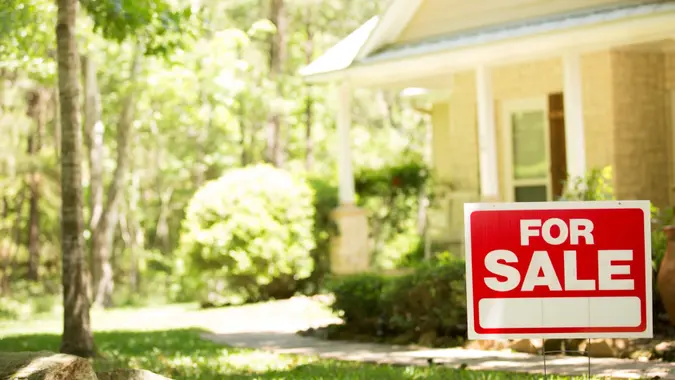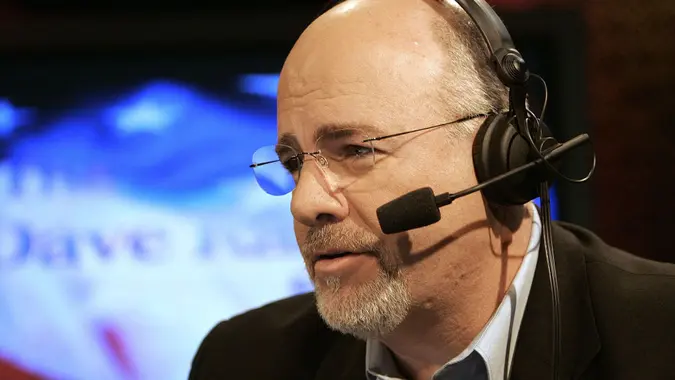How the Average Cost of a Home Has Changed in the Last 10 Years

Commitment to Our Readers
GOBankingRates' editorial team is committed to bringing you unbiased reviews and information. We use data-driven methodologies to evaluate financial products and services - our reviews and ratings are not influenced by advertisers. You can read more about our editorial guidelines and our products and services review methodology.

20 Years
Helping You Live Richer

Reviewed
by Experts

Trusted by
Millions of Readers
Housing has always been a hot topic of debate, especially as buyers continue to be priced out of the market. The once attainable “American Dream” of homeownership is now plagued with rising costs and stiff competition.
Although these trends started decades ago, the past 10 years have seen some drastic changes in the average home sale price. Here’s how the average cost of a home has changed in the last 10 years, including factors that influenced home prices, based on GOBankingRates research.
2014: Strong Economic Rebounds
The economy was strong in 2014, marking the biggest rebound since the Great Recession. The average home sale price in 2014 was $347,700. With inflation, this equates to about $459,590. Part of the economic rebound is attributed to high job growth and low unemployment rates.
2015: Continued Growth
The economy and housing market continued to build off 2014’s momentum. The spring of 2015 saw the best home-building numbers since 2007. The average home sale price reached $352,700, or about $466,542 when inflation is factored in.
2016: A New Presidency
In 2016, former President Donald Trump was elected to office, and the Dow Jones Industrial Average surged to 19,000 for the first time. Similarly, housing prices reached a new high at an average sale price of $360,900. In 2024’s currency, this would be about $473,354.
2017: Consumer Confidence Soars
With Trump setting 3% growth targets for his first year in office, the economy continued to grow along with consumer confidence. Consumer confidence reached its highest point since 2000, while unemployment remained low and the economy solidified a 2.3% growth rate. These factors trickled down into home prices increasing to $384,900. In today’s currency, this amount equates to $462,347.
2018: Strong But Steady
2018 remained a strong year despite a few mishaps. The Dow Jones Industrial Average exceeded 26,000; however, it also sustained the largest one-day drop, falling by 1,597 points. Other stock trading platforms also announced declines, including the Nasdaq and S&P 500. Housing prices did not fall, but they did remain around 2017 levels, with an average home sale price of $385,000 or $481,851 when converted to today’s currency with inflation.
2019: Turbulence in Office
Housing prices dipped in 2019 to an average home sale price of $383,900, which is $471,689 with inflation factored in. One of the main causes of the receding market was turbulence at the White House. The House of Representatives voted to impeach Trump, while Former FBI Director Robert Mueller launched an investigation into the former president’s campaign.
2020: The Pandemic Kick-Off
2020 started the rapid rise in housing prices, with the pandemic in full swing by March 2020. Trump declared a national emergency, unlocking $50 billion in federal funds. At the same time, non-essential businesses shut down, sports leagues were halted and travel bans were enforced. The average home sale price jumped to $391,900 or $474,219 when factoring in inflation.
2021: Antsy Americans
By the time 2021 rolled around, Americans were antsy about stay-at-home orders and shut down businesses. This triggered a new wave of home purchases to accommodate lifestyle changes. In 2021, housing prices advanced 18.8% to $464,200. In 2024 dollars, this is $547,365.
2022: Severe Shortages
Average home sale prices grew in 2022 to $540,000, or $586,633 in today’s dollars. Even with interest rates cooling, the demand for new housing continued to climb. Inflation and the cost of living reached their highest levels in 40 years.
2023: Rising Rates
With the Federal Reserve raising rates seven times in 2022, the housing market started to cool. The average home sale price was $513,800 or $531,667 in 2024’s currency. Despite the drop, the cost of financing a home remained too high for many Americans.
The Bottom Line
Increases in the average home sale price aren’t inherently bad. In fact, growth in home prices does mean the economy is growing. However, the pandemic created widespread shortages. With supply still low and interest rates high, many Americans are having difficulty entering the market.
Methodology: For this study, GOBankingRates found the national average home sale price from 1963 to 2023 in years sold dollars as well as current dollars. Using the US Census’s New Residential Construction Average Home Sale Price, GOBankingRates found the historical average home sales price starting in 1963. Using the Bureau of Labor Statistics Consumer Price Index Inflation Calculator, the historical home price can be calculated in 2024 dollars. All data was collected on and is up to date as of May 24, 2024.
 Written by
Written by  Edited by
Edited by 

























